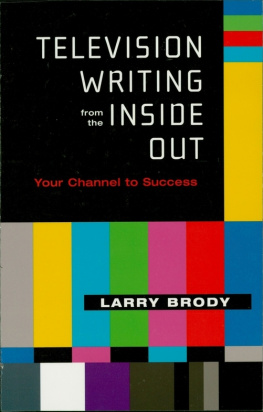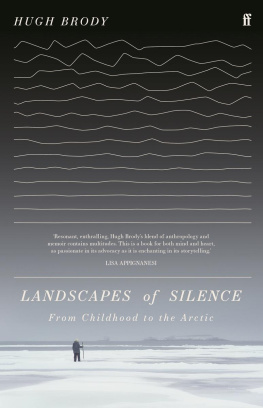BRODY
The Triumph and Tragedy of
Wrestlings Rebel
LARRY MATYSIK AND
BARBARA GOODISH

Copyright Larry Matysik and Barbara Goodish, 2007
Published by ECW PRESS
2120 Queen Street East, Suite 200
Toronto, Ontario, Canada M4E LE2
416.694.3348 / info@ecwpress.com
All rights reserved. No part of this publication may be reproduced, stored in a retrieval system, or transmitted in any form by any process electronic, mechanical, photocopying, recording, or otherwise without the prior written permission of the copyright owners and ECW PRESS.
LIBRARY AND ARCHIVES CANADA CATALOGUING IN PUBLICATION
Matysik, Larry
Brody : the triumph and tragedy of wrestlings rebel / Larry Matysik and Barbara Goodish.
ISBN-13: 978-1-55022-760-4
ISBN-10: 1-55022-760-2
1. Brody, Bruiser, 1946-1988. 2. Wrestler United
States Biography.
I. Goodish, Barbara II. Title.
GV1196.b76M38 2007 796.812092 C2006-906801-1
Editor: Michael Holmes
Cover and Text Design: Tania Craan
Typesetting: Mary Bowness
Photo Insert and Production: Rachel Brooks
Cover Photo: Jeanne Rohner
Second Printing: Printcrafters
This book is set in Adobe Garamond and Trajan
The thoughts expressed by Matysik and Goodish are the material of the individual author.
PRINTED AND BOUND IN CANADA

CONTENTS
Acknowledgements and
A Note on Style and Illustrations
Many deserve thanks when a book such as Brody: The Triumph and Tragedy of Wrestlings Rebel comes together. Frank Goodish was a unique personality in his own right, and he created an unforgettable character in Bruiser Brody. Those who honestly understood both sides of this complicated man made valuable contributions to the book. Thus, we offer thanks to many, but especially to the following individuals.
Pete Ortega opened his heart to share with us his friendship with Frank. Pete and his wife Rowe knew who Frank really was. Ronnie and Dede Middleton also described the private side of Frank they had come to know. Thanks also to Gerry Cohen and William and Mary Kirkwood.
Those in wrestling who actually were friends of Frank Goodish were generous with their time and knowledge. They didnt get detoured just telling tall tales, but offered fact, analysis, and affection for a friend.
Thanks to Buck Robley, Gary Hart, and Stan Hansen, who were incredibly open about their experiences. Bobby Jaggers and Terry Funk added so much about Frank. They helped us capture who he was and explain his place in a crazy business.
Victor Quinones was completely open and intense about what he knew and why the terrible tragedy happened.
Dave Meltzer had a different perspective from which to consider Frank, and Jim Ross explained another aspect of Franks personality. Matt Farmer furnished excellent research about Franks in-ring record. Mel Hutnick, a wise attorney, was always able to suggest new and objective insights. Charles Holmes, with his computer expertise, and Kelly Matysik, with her photographic skill, were invaluable. Pat Matysik was a sharp proofreader and critic.
Michael Holmes of ECW Press has been much more than just an editor. Michael believed in this book from day one and had great advice, guidance, and friendship to provide.
Most of all, thanks go to the many dedicated fans who kept Bruiser Brody, the other part of Frank Goodish, alive. It is their passion that has made Brody a legend. Frank Goodish would want to tell them, Thanks. So do we.
When Barbara Goodish and I began writing Brody, the biggest question was how to make clear who was talking. Michael Holmes, our editor with ECW Press, walked us through the process and we hope the result makes it easy for everyone to follow and understand the story of this very complex and entertaining character.
Chapters featuring the specific recollections of Barbara, Franks wife, are prefaced with her name.
The excellent photographs come from the collection of Barbara Goodish, as well as from Roger Deem, Mike Gratchner, Hal LaPorte, J.R. Obrecht, and Linda Roufa. The cover photo is by Jeanne Rohner.
Parts of this tale are difficult and dark, while others are fun and, hopefully, informative. Putting it all together was tremendously satisfying for both of us. Our fondest hope is that you will find it just as compelling.
Larry Matysik, 2007
For Geoff and for Millie, Gayle, Gloria and Kathy B.G.
As always, for Pat and for Kelly L.M.
FOREWORD
by Dave Meltzer

When you look back at both the wrestler and the person Frank Bruiser Brody Goodish was, it becomes clear just how much wrestling has changed in the past 19 years. Looking back reveals a crazy picture.
In the 1980s, Bruiser Brody represented a fascinating dichotomy. True fans of wrestling recognized him as one of the three or four biggest stars in the game. Not only was he a legend in Japan, at a time when the popularity and standard of wrestling in that country far exceeded that in the United States, but he was a superstar wherever he wrestled in America as well. Brody was a genuine drawing card, whether it was for the various promoters trying to survive Vince McMahons (and later Jim Crockett Jr.s) national onslaught, or for small, independent promoters looking for a big name to spice their gates.
But because he never appeared in the post-1984 World Wrestling Federation, a large percentage of casual fans never really got to know him. With this book readers will get to know him very well.
When Brody died, I recall a newspaper reporter from Chicago, who was a big fan, saying he wanted to write Brodys obituary. He understood that Brody was one of the worlds biggest stars, but his editors couldnt see how that was possible. Sure, they argued, he may have wrestled in front of some big crowds in Chicago for Verne Gagne, but if he was such a big star, why wasnt he in the WWF?
Its almost impossible to adequately explain the role he filled to a fan accustomed to contemporary wrestling. Wrestling, in terms of traditional competitive sports, was no more real in those days than it is today. But it was presented in a more realistic manner. Accordingly, there was an inherent belief whether true or not that a pro wrestlers toughness truly mattered. It added to his aura, his stardom.
Today, nobody ever wonders whether wrestling is real, or asks whos going to be world champion or win a specific match. In the 1980s, however, those were the questions I was asked most frequently.
There was nobody better at projecting real danger than Brody. He was someone you just didnt mess with. When you watched him wrestle, you couldnt be sure, in fact, that a match hadnt become real. And that was always his goal.
He had a theory, for example, about throwing effective kicks. Hed lay in a few easy ones, so fans would get used to them, and because of how he worked, he was believable enough just doing that. Then, at the right moment, hed land a hard kick that made a truly nasty thud. Now, Brodys kicks were no more devastating than the hard kicks thrown by todays wrestlers, but tell that to anyone who watched him back then. It was how he set the thing up the unexpected power and his sense of timing that unsettled fans, and made entire audiences unsure about what theyd just seen.







